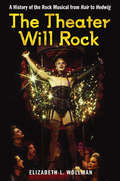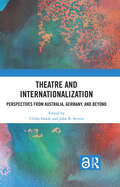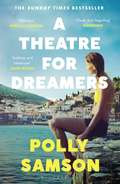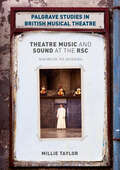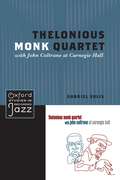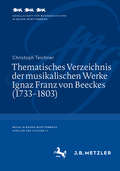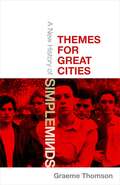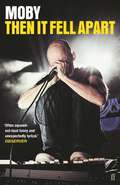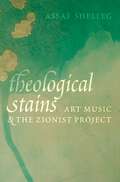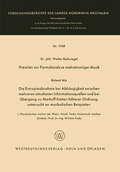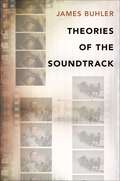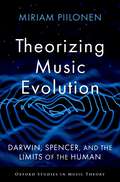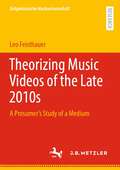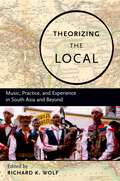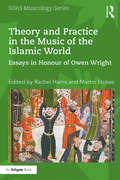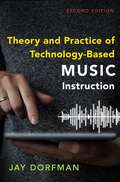- Table View
- List View
The Theater Will Rock: A History of the Rock Musical, from Hair to Hedwig (Anthropology series)
by Elizabeth Lara WollmanThe tumultuous decade of the 1960s in America gave birth to many new ideas and forms of expression, among them the rock musical. An unlikely offspring of the performing arts, the rock musical appeared when two highly distinctive and American art forms joined onstage in New York City. The Theater Will Rock explores the history of the rock musical, which has since evolved to become one of the most important cultural influences on American musical theater and a major cultural export. Packed with candid commentary by members of New York's vibrant theater community, The Theater Will Rock traces the rock musical's evolution over nearly fifty years, in popular productions such as Hair, The Who's Tommy, Jesus Christ Superstar, The Rocky Horror Picture Show, Little Shop of Horrors, Rent, and Mamma Mia!---and in notable flops such as The Capeman. "A much-needed study of the impact of rock music on the musical theater and its resulting challenges, complexities, failures, and successes. Anyone interested in Broadway will learn a great deal from this book." ---William Everett, author of The Musical: A Research Guide to Musical Theatre "This well-written account puts the highs and lows of producing staged rock musicals in New York City into perspective and is well worth reading for the depth of insight it provides." ---Studies in Musical Theatre Elizabeth L. Wollman is Assistant Professor of Music at Baruch College, City University of New York.
Theatre and Internationalization: Perspectives from Australia, Germany, and Beyond
by Ulrike Garde John R. SevernTheatre and Internationalization examines how internationalization affects the processes and aesthetics of theatre, and how this art form responds dramatically and thematically to internationalization beyond the stage. With central examples drawn from Australia and Germany from the 1930s to the present day, the book considers theatre and internationalization through a range of theoretical lenses and methodological practices, including archival research, aviation history, theatre historiography, arts policy, organizational theory, language analysis, academic-practitioner insights, and literary-textual studies. While drawing attention to the ways in which theatre and internationalization might be contributing productively to each other and to the communities in which they operate, it also acknowledges the limits and problematic aspects of internationalization. Taking an unusually wide approach to theatre, the book includes chapters by specialists in popular commercial theatre, disability theatre, Indigenous performance, theatre by and for refugees and other migrants, young people as performers, opera and operetta, and spoken art theatre. An excellent resource for academics and students of theatre and performance studies, especially in the fields of spoken theatre, opera and operetta studies, and migrant theatre, Theatre and Internationalization explores how theatre shapes and is shaped by international flows of people, funds, practices, and works.
Theatre and Internationalization: Perspectives from Australia, Germany, and Beyond
by Ulrike Garde John R. SevernTheatre and Internationalization examines how internationalization affects the processes and aesthetics of theatre, and how this art form responds dramatically and thematically to internationalization beyond the stage. With central examples drawn from Australia and Germany from the 1930s to the present day, the book considers theatre and internationalization through a range of theoretical lenses and methodological practices, including archival research, aviation history, theatre historiography, arts policy, organizational theory, language analysis, academic-practitioner insights, and literary-textual studies. While drawing attention to the ways in which theatre and internationalization might be contributing productively to each other and to the communities in which they operate, it also acknowledges the limits and problematic aspects of internationalization. Taking an unusually wide approach to theatre, the book includes chapters by specialists in popular commercial theatre, disability theatre, Indigenous performance, theatre by and for refugees and other migrants, young people as performers, opera and operetta, and spoken art theatre. An excellent resource for academics and students of theatre and performance studies, especially in the fields of spoken theatre, opera and operetta studies, and migrant theatre, Theatre and Internationalization explores how theatre shapes and is shaped by international flows of people, funds, practices, and works.
Theatre for Dreamers: An Observer Fiction Highlight 2020
by Polly SamsonAn Observer Fiction Highlight 2020'Oh my god, this book! I don't have words to convey its brilliance' MARIAN KEYES'A glorious novel' KATE MOSSE'If summer was suddenly like a novel, it would be like this one' ANDREW O'HAGAN'The best book I've read all year' JOANNE HARRIS'Superb' THOMAS KENEALLY1960. The world is dancing on the edge of revolution, and nowhere more so than on the Greek island of Hydra, where a circle of poets, painters and musicians live tangled lives, ruled by the writers Charmian Clift and George Johnston, troubled king and queen of bohemia. Forming within this circle is a triangle: its points the magnetic, destructive writer Axel Jensen, his dazzling wife Marianne Ihlen, and a young Canadian poet named Leonard Cohen. Into their midst arrives teenage Erica, with little more than a bundle of blank notebooks and her grief for her mother. Settling on the periphery of this circle, she watches, entranced and disquieted, as a paradise unravels. Burning with the heat and light of Greece, A Theatre for Dreamers is a spellbinding novel about utopian dreams and innocence lost – and the wars waged between men and women on the battlegrounds of genius.
A Theatre for Dreamers: The Sunday Times bestseller
by Polly SamsonTHE SUNDAY TIMES BESTSELLERA SUMMER READING PICK IN THE GUARDIAN, SUNDAY TIMES, THE TIMES, DAILY MAIL, FINANCIAL TIMES AND EVENING STANDARD'The Greek island of Hydra is the star of this novel about a young woman and a 1960s bohemian community' SUNDAY TIMES, Summer Reading Pick 2020 'Samson summons the vision and the reality in a beguiling, deeply evocative portrait of a vanished era' GUARDIAN, Summer Reading Pick 2020'It's sleazy, evocative, beautiful and entertaining' STUART TURTON, GUARDIAN, Summer Reading Pick 2020'Heady armchair escapism ... An impressionistic, intoxicating rush of sensory experience' Sunday Times 'Sublime and immersive … If you wish you could disappear to a Greek island right now, I highly recommend' JOJO MOYES'A surefire summer hit ... feels at once like a gift and an escape route' Observer1960. The world is dancing on the edge of revolution, and nowhere more so than on the Greek island of Hydra, where a circle of poets, painters and musicians live tangled lives, ruled by the writers Charmian Clift and George Johnston, troubled king and queen of bohemia. Forming within this circle is a triangle: its points the magnetic, destructive writer Axel Jensen, his dazzling wife Marianne Ihlen, and a young Canadian poet named Leonard Cohen. Into their midst arrives teenage Erica, with little more than a bundle of blank notebooks and her grief for her mother. Settling on the periphery of this circle, she watches, entranced and disquieted, as a paradise unravels. Burning with the heat and light of Greece, A Theatre for Dreamers is a spellbinding novel about utopian dreams and innocence lost – and the wars waged between men and women on the battlegrounds of genius. An Observer Fiction Highlight 2020'Could hardly have come at a better time … Samson recreates one heady summer there (the Greek island of Hydra) with impeccably ripening prose, all thyme-scented hills and cascading bougainvillea' i paper'Beautiful' DOLLY ALDERTON'Delicious' NIGELLA LAWSON'Intoxicating' Spectator'Oh my god, this book! I don't have words to convey its brilliance' MARIAN KEYES'A glorious novel' KATE MOSSE'If summer was suddenly like a novel, it would be like this one' ANDREW O'HAGAN'The best book I've read all year' JOANNE HARRIS'Superb' THOMAS KENEALLYA SUNDAY TIMES TOP TEN BESTSELLER (APRIL 2020)
Theatre Music and Sound at the RSC: Macbeth to Matilda (Palgrave Studies in British Musical Theatre)
by Millie TaylorThis book discusses an exciting laboratory that has been developing the practice of theatre music composition and sound design since 1961: the Royal Shakespeare Company. Musical practices have evolved as composers and musical directors inherited from the past and innovated with new technology; different interpretations of single plays in multiple iterations have provided a picture of developing styles, genres, working practices, technologies and contexts; actor musicianship has been practiced quietly and without fuss; and the role of the sound designer has appeared and transformed the theatrical soundscape. This book moves to musical theatre to evidence a continuum between its rich interdisciplinary textures and the musicodramatic world of Shakespeare’s plays, positioning the RSC as an innovative company that continually expands the creative and collaborative possibilities of the theatre.
Thelonious Monk Quartet with John Coltrane at Carnegie Hall (Oxford Studies in Recorded Jazz)
by Gabriel SolisIn early 2005, an engineer at the Library of Congress accidentally discovered, in an unmarked box, the recording of Thelonious Monk's and John Coltrane's performance at a 1957 benefit concert at Carnegie Hall. Long considered one of the most important musical meetings in modern jazz, Monk's and Coltrane's work together during a scant few months in 1957 had, until this discovery, been thought to be almost entirely undocumented. In this book, Gabriel Solis provides an historical, cultural, and analytical study of this landmark recording, which was released by Blue Note records later in 2005. Taking a wide-ranging approach to the recording, Solis addresses issues of "liveness," jazz teaching and learning, enculturation, and historiography. Because nearly a half century passed between when the recording was made and its public release, it is a particularly interesting lens through which to view jazz both as a historical tradition and as a contemporary cultural form. Most importantly Solis accounts for the music itself. Offering in depth analytical discussions of each composition, as well as Monk's and Coltrane's improvisational performances he provides insight into Monk's impact on Coltrane as he developed his signature "sheets of sound" style, as well as into the influence of a strong side-man, like Coltrane, on Monk at his creative and professional peak. The first study of one of the most significant jazz releases of the twenty-first century, Thelonious Monk Quartet with John Coltrane at Carnegie Hall is essential reading for all jazz scholars, students, musicians, and fans.
Thelonious Monk Quartet with John Coltrane at Carnegie Hall (Oxford Studies in Recorded Jazz)
by Gabriel SolisIn early 2005, an engineer at the Library of Congress accidentally discovered, in an unmarked box, the recording of Thelonious Monk's and John Coltrane's performance at a 1957 benefit concert at Carnegie Hall. Long considered one of the most important musical meetings in modern jazz, Monk's and Coltrane's work together during a scant few months in 1957 had, until this discovery, been thought to be almost entirely undocumented. In this book, Gabriel Solis provides an historical, cultural, and analytical study of this landmark recording, which was released by Blue Note records later in 2005. Taking a wide-ranging approach to the recording, Solis addresses issues of "liveness," jazz teaching and learning, enculturation, and historiography. Because nearly a half century passed between when the recording was made and its public release, it is a particularly interesting lens through which to view jazz both as a historical tradition and as a contemporary cultural form. Most importantly Solis accounts for the music itself. Offering in depth analytical discussions of each composition, as well as Monk's and Coltrane's improvisational performances he provides insight into Monk's impact on Coltrane as he developed his signature "sheets of sound" style, as well as into the influence of a strong side-man, like Coltrane, on Monk at his creative and professional peak. The first study of one of the most significant jazz releases of the twenty-first century, Thelonious Monk Quartet with John Coltrane at Carnegie Hall is essential reading for all jazz scholars, students, musicians, and fans.
Thematisches Verzeichnis der musikalischen Werke Ignaz Franz von Beeckes (Musik in Baden-Württemberg | Quellen und Studien #11)
by Christoph TeichnerIgnaz Franz von Beecke (1733–1803), von den Zeitgenossen gefeierter Pianist und Komponist, diente zeitlebens dem fürstlichen Haus Oettingen-Wallerstein. Geboren in Wimpfen/Neckar, formierte Beecke als Intendant der Hofmusik die Wallersteiner Hofkapelle zu einem der führenden Klangkörper des 18. Jahrhunderts. Zahlreiche Reisen führten ihn in die musikalischen Zentren Europas (Paris, Wien, Mannheim), wo er seine Singspiele, Sinfonien und Klavierkonzerte zur Aufführung brachte. Spektakulär war ein Klavierduell mit W. A. Mozart in München, aus dem Beecke 1775 als Gewinner hervorging. - Der thematische Katalog (mit aussagekräftigen Notenbeispielen) verzeichnet sämtliche 334 Musikwerke und erfasst erstmals Beeckes Gesamtschaffen. Enthalten ist auch eine biographische Skizze auf Basis von 425 aufgefundenen Briefen und weiteren Schriftstücken.
Themes for Great Cities: A New History of Simple Minds
by Graeme Thomson'Nobody owes us anything, but the Simple Minds story has been too condensed. After Live Aid and 'Don't You (Forget About Me)' there hasn't been quite the credit for those first few records. I think they contain some really special music. I can hear the flaws but there's something about the spirit and imagination in them that feels good. They draw from such a wide range of influences ... but the spirit of it was always Simple Minds.' Jim Kerr, to the authorAn illuminating new biography of one of Britain's biggest and most influential bands, written with the full input and cooperation of Simple Minds, shedding new light on their dazzling art-rock legacy.Themes for Great Cities features in-depth new interviews with original band members Jim Kerr, Charlie Burchill, Mick MacNeil and Derek Forbes, alongside key figures from within their creative community and high-profile fans such as Bobby Gillespie, James Dean Bradfield and Mogwai's Stuart Braithwaite. The book reclaims and revivifies the magnificence of Simple Minds' pioneering early albums, from the glitchy Euro-ambience of Real to Real Cacophony and Empires and Dance to the pulsing, agitated romance of Sons and Fascination, New Gold Dream and beyond.Emerging in 1978 from Glasgow's post-punk scene, Simple Minds transitioned from restless art-rock to electro futurism, mutated into passionate pop contenders and, finally, a global rock behemoth. They have sold in the region of 60 million records and remain a worldwide phenomenon. The drama of their tale lies in these transformations and triumphs, conflicts and contradictions.Themes for Great Cities tells the inside story of a band becoming a band. Inspiring, insightful and enlightening, it celebrates the trailblazing music of one of Britain's greatest groups.
Then It Fell Apart
by MobyWhat do you do when you realise you have everything you think you've ever wanted but still feel completely empty? What do you do when it all starts to fall apart? The second volume of Moby's extraordinary life story is a journey into the dark heart of fame and the demons that lurk just beneath the bling and bluster of the celebrity lifestyle. In summer 1999, Moby released the album that defined the millennium, PLAY. Like generation-defining albums before it, PLAY was ubiquitous, and catapulted Moby to superstardom. Suddenly he was hanging out with David Bowie and Lou Reed, Christina Ricci and Madonna, taking esctasy for breakfast (most days), drinking litres of vodka (every day), and sleeping with super models (infrequently). It was a diet that couldn't last. And then it fell apart. The second volume of Moby's memoir is a classic about the banality of fame. It is shocking, riotously entertaining, extreme, and unforgiving. It is unedifying, but you can never tear your eyes away from the page.
Theological Stains: Art Music and the Zionist Project
by Assaf ShellegTheological Stains offers the first in-depth study of the development of art music in Israel from the mid-twentieth century to the turn of the twenty-first. In a bold and deeply researched account, author Assaf Shelleg explores the theological grammar of Zionism and its impact on the art music written by emigrant and native composers. He argues that Israeli art music, caught in the tension between a bibliocentric territorial nationalism on the one hand and the histories of deterritorialized Jewish diasporic cultures on the other, often features elements of both of these competing narratives. Even as composers critically engaged with the Zionist paradigm, they often reproduced its tropes and symbols, thereby creating aesthetic hybrids with 'theological stains.' Drawing on newly uncovered archives of composers' autobiographical writings and musical sketches, Shelleg closely examines the aesthetic strategies that different artists used to grapple with established nationalist representations. As he puts the history of Israeli art music in conversation with modern Hebrew literature, he weaves a rich tapestry of Israeli culture and the ways in which it engaged with key social and political developments throughout the second half of the twentieth century. In analyzing Israeli music and literature against the backdrop of conflicts over territory, nation, and ethnicity, Theological Stains provides a revelatory look at the complex relationship between art and politics in Israel.
Theological Stains: Art Music and the Zionist Project
by Assaf ShellegTheological Stains offers the first in-depth study of the development of art music in Israel from the mid-twentieth century to the turn of the twenty-first. In a bold and deeply researched account, author Assaf Shelleg explores the theological grammar of Zionism and its impact on the art music written by emigrant and native composers. He argues that Israeli art music, caught in the tension between a bibliocentric territorial nationalism on the one hand and the histories of deterritorialized Jewish diasporic cultures on the other, often features elements of both of these competing narratives. Even as composers critically engaged with the Zionist paradigm, they often reproduced its tropes and symbols, thereby creating aesthetic hybrids with 'theological stains.' Drawing on newly uncovered archives of composers' autobiographical writings and musical sketches, Shelleg closely examines the aesthetic strategies that different artists used to grapple with established nationalist representations. As he puts the history of Israeli art music in conversation with modern Hebrew literature, he weaves a rich tapestry of Israeli culture and the ways in which it engaged with key social and political developments throughout the second half of the twentieth century. In analyzing Israeli music and literature against the backdrop of conflicts over territory, nation, and ethnicity, Theological Stains provides a revelatory look at the complex relationship between art and politics in Israel.
Theorien zur Formalanalyse mehrstimmiger Musik: Die Entropieabnahme bei Abhängigkeit zwischen mehreren simultanen Informationsquellen und bei Übergang zu Markoff-Ketten höherer Ordnung, untersucht an musikalischen Beispielen (Forschungsberichte des Landes Nordrhein-Westfalen #1768)
by Walter ReckziegelDer vorliegende Bericht stützt sich auf die Arbeiten von WILHELM PUCKS und baut auf den Methoden und Ergebnissen des genannten Autors auf. Die Kenntnis der im Verzeichnis angeführten Literatur darf vorausgesetzt werden. Die im Text erwähnten statistischen Begriffe (Mittelwert, Streuung etc. ) wurden von FUCKS zur Untersuchung musikalischer Elemente benutzt. Er stellte eine Reihe von Analysen an, indem er zunächst die relative Häufigkeit der Tonhöhen einstimmiger Melodien (Violin- und Flötenstimmen, Gesangs-Oberstimmen aus klassischen Werken von etwa 1500 bis heute) berechnete. Es wurde gezeigt, daß die Streuung und die Entropie der Zahlenwerte unabhängig voneinander proportional zur Entstehungszeit der Musik monoton ansteigen. Sodann wurden Intervalle zwischen je zwei benachbarten Tönen gebildet und ebenfalls deren Häufigkeit ausgezählt. Da hier die Streuung wegen der qualitativen Gleichheit oktavversetzter Töne als Hilfsmittel unbrauchbar ist, wurde die Kyrtosis der Zahlenwerte be rechnet. Trägt man die erhaltenen Werte wieder als Punktion der Zeit auf, so erfolgt nur zum Teil ein monotoner Anstieg; eine Gruppe von Zwölftonkompo sitionen dagegen sinkt auffallend tief, sogar noch unter die Werte der Barockzeit und der franko-flämischen Periode, ab. Die sog. Tonhöhenübergangsmatrix in den erwähnten Arbeiten gibt ein anschau liches Bild davon, welche Töne jeweils aufeinander folgen. Vergrößert man den Abstand zwischen den benachbarten Elementen schrittweise um 1, so kann für jeden Abstand q eine weitere Matrix aufgestellt werden. Die Übergangsmatrizen q-ter Ordnung lassen sich durch Korrelationsellipsen ersetzen, die zwischen den Grenzfällen »Parallele Geraden« und »Kreis« alle möglichen Formen annehmen können. Dasselbe Verfahren läßt sich auch auf Intervallpaare anwenden.
Theories of the Soundtrack (Oxford Music/Media Series)
by James BuhlerA theory of the soundtrack is concerned with what belongs to the soundtrack, how a soundtrack is effectively organized, how its status in a multimedia object affects the nature of the object, the tools available for its analysis, and the interpretive regime that the theory mandates for determining the meaning, sense, and structure that sound and music bring to film and other audiovisual media. Beyond that, a theory may also delineate the range of possible uses of sound and music, classify the types of relations that films have used for image and sound, identify the central problems, and reflect on and describe effective uses of sound in film. This book summarizes and critiques major theories of the soundtrack from roughly 1929 until today. Rather than providing an exhaustive historical survey, it sketches out the range of theoretical approaches that have been applied to the soundtrack since the commercial introduction of the sound film. The basic theoretical framework of each approach is presented, taking into account the explicit and implicit claims about the soundtrack and its relation to other theories. The organization is both chronological and topical, the former in that the chapters move steadily from early film theory through models of the classical system to more recent critical theories; the latter in that the chapters highlight central issues for each generation: the problem of film itself, then of image and sound, of adequate analytical-descriptive models, and finally of critical-interpretative models.
Theories of the Soundtrack (Oxford Music/Media Series)
by James BuhlerA theory of the soundtrack is concerned with what belongs to the soundtrack, how a soundtrack is effectively organized, how its status in a multimedia object affects the nature of the object, the tools available for its analysis, and the interpretive regime that the theory mandates for determining the meaning, sense, and structure that sound and music bring to film and other audiovisual media. Beyond that, a theory may also delineate the range of possible uses of sound and music, classify the types of relations that films have used for image and sound, identify the central problems, and reflect on and describe effective uses of sound in film. This book summarizes and critiques major theories of the soundtrack from roughly 1929 until today. Rather than providing an exhaustive historical survey, it sketches out the range of theoretical approaches that have been applied to the soundtrack since the commercial introduction of the sound film. The basic theoretical framework of each approach is presented, taking into account the explicit and implicit claims about the soundtrack and its relation to other theories. The organization is both chronological and topical, the former in that the chapters move steadily from early film theory through models of the classical system to more recent critical theories; the latter in that the chapters highlight central issues for each generation: the problem of film itself, then of image and sound, of adequate analytical-descriptive models, and finally of critical-interpretative models.
Theorizing Music Evolution: Darwin, Spencer, and the Limits of the Human (Oxford Studies in Music Theory)
by Miriam PiilonenWhat did historical evolutionists such as Charles Darwin and Herbert Spencer have to say about music? What role did music play in their evolutionary theories? What were the values and limits of these evolutionist turns of thought, and in what ways have they endured in present-day music research? Theorizing Music Evolution: Darwin, Spencer, and the Limits of the Human is a critical examination of ideas about musical origins, emphasizing nineteenth-century theories of music in the evolutionist writings of Darwin and Spencer. Author Miriam Piilonen argues for the significance of this Victorian music-evolutionism in light of its ties to a recently revitalized subfield of evolutionary musicology. Taking an interdisciplinary approach to music theorizing, Piilonen explores how historical thinkers constructed music in evolutionist terms and argues for an updated understanding of music as an especially fraught area of evolutionary thought. In this book, Piilonen delves into how historical evolutionists, in particular Darwin and Spencer, developed and applied a concept of music that served as a boundary-drawing device, used to trace or obscure the conceptual borders between human and animal. She takes as primary texts the early evolutionary treatises that double as theoretical accounts of music's origins. For Darwin, music served as a kind of proto-language common to humans and animals alike; he heard the songs of birds and the chirps of mice as musical, as articulated in texts such as The Descent of Man (1871) and The Expression of the Emotions in Man and Animals (1872). Spencer, on the other hand, viewed music as a specifically human stage of evolutionary advance, beyond language acquisition, as outlined in his essay, "The Origin and Function of Music" (1857). These competing views established radically different perspectives on the origin and function of music in human cultural expression, while at the same time being mutually constitutive of one another. A ground-breaking contribution to music theory and histories of science, Theorizing Music Evolution turns to music evolution with an eye toward disrupting and intervening in these questions as they recur in the present.
Theorizing Music Evolution: Darwin, Spencer, and the Limits of the Human (Oxford Studies in Music Theory)
by Miriam PiilonenWhat did historical evolutionists such as Charles Darwin and Herbert Spencer have to say about music? What role did music play in their evolutionary theories? What were the values and limits of these evolutionist turns of thought, and in what ways have they endured in present-day music research? Theorizing Music Evolution: Darwin, Spencer, and the Limits of the Human is a critical examination of ideas about musical origins, emphasizing nineteenth-century theories of music in the evolutionist writings of Darwin and Spencer. Author Miriam Piilonen argues for the significance of this Victorian music-evolutionism in light of its ties to a recently revitalized subfield of evolutionary musicology. Taking an interdisciplinary approach to music theorizing, Piilonen explores how historical thinkers constructed music in evolutionist terms and argues for an updated understanding of music as an especially fraught area of evolutionary thought. In this book, Piilonen delves into how historical evolutionists, in particular Darwin and Spencer, developed and applied a concept of music that served as a boundary-drawing device, used to trace or obscure the conceptual borders between human and animal. She takes as primary texts the early evolutionary treatises that double as theoretical accounts of music's origins. For Darwin, music served as a kind of proto-language common to humans and animals alike; he heard the songs of birds and the chirps of mice as musical, as articulated in texts such as The Descent of Man (1871) and The Expression of the Emotions in Man and Animals (1872). Spencer, on the other hand, viewed music as a specifically human stage of evolutionary advance, beyond language acquisition, as outlined in his essay, "The Origin and Function of Music" (1857). These competing views established radically different perspectives on the origin and function of music in human cultural expression, while at the same time being mutually constitutive of one another. A ground-breaking contribution to music theory and histories of science, Theorizing Music Evolution turns to music evolution with an eye toward disrupting and intervening in these questions as they recur in the present.
Theorizing Music Videos of the Late 2010s: A Prosumer’s Study of a Medium (Zeitgenössische Musikwissenschaft)
by Leo FeisthauerThe work formulates a status quo of the music video medium in the late 2010s and shows which trends, aesthetics and (new) standards have established themselves. Particularly the role of the prosumer amidst evolved technical conditions is highlighted in this context, which strongly influences the evolution of music video in this period. Moreover, the author understands music videos as socio-political actors and examines the resulting questions of their interaction with culture.
Theorizing the Local: Music, Practice, and Experience in South Asia and Beyond
by Richard WolfOver the past four decades, the "globalized" aspects of cultural circulation have received the majority of scholarly-and consumer-attention, particularly in the study of South Asian music. As a result, a broad range of community-based and other locally focused performance traditions in the regions of South Asia have remained relatively unexplored. Theorizing the Local provides a challenging and compelling counterperspective to the "globalized," arguing for the value of comparative microstudies that are not concerned primarily with the flow of capital and neoliberal politics. What does it mean for musical activities to be local in an increasingly interconnected world? To what extent can theoretical activity be localized to the very acts of making music, interacting, and composing? Theorizing the Local offers glimpses into rich musical worlds of south and west Asia, worlds which have never before been presented in a single volume. The authors cross the traditional borders of scholarship and region, exploring in unmatched detail a vast array of musical practices and significant ethnographic discoveries-from Nepal to India, India to Sri Lanka, Pakistan to Iran. Enriched by audio and video tracks on an extensive companion Web site, Theorizing the Local is an important study of South Asian musical traditions that offers a broader understanding of 21st-century music of the world.
Theorizing the Local: Music, Practice, and Experience in South Asia and Beyond
by Richard K. WolfOver the past four decades, the "globalized" aspects of cultural circulation have received the majority of scholarly-and consumer-attention, particularly in the study of South Asian music. As a result, a broad range of community-based and other locally focused performance traditions in the regions of South Asia have remained relatively unexplored. Theorizing the Local provides a challenging and compelling counterperspective to the ?globalized,? arguing for the value of comparative microstudies that are not concerned primarily with the flow of capital and neoliberal politics. What does it mean for musical activities to be local in an increasingly interconnected world? To what extent can theoretical activity be localized to the very acts of making music, interacting, and composing? Theorizing the Local offers glimpses into rich musical worlds of south and west Asia, worlds which have never before been presented in a single volume. The authors cross the traditional borders of scholarship and region, exploring in unmatched detail a vast array of musical practices and significant ethnographic discoveries-from Nepal to India, India to Sri Lanka, Pakistan to Iran. Enriched by audio and video tracks on an extensive companion Web site, Theorizing the Local is an important study of South Asian musical traditions that offers a broader understanding of 21st-century music of the world.
Theory and Practice in the Music of the Islamic World: Essays in Honour of Owen Wright (SOAS Studies in Music Series)
by Rachel Harris Martin StokesThis volume of original essays is dedicated to Owen Wright in recognition of his formative contribution to the study of music in the Islamic Middle East. Wright’s work, which comprises, at the time of writing, six field-defining volumes and countless articles, has reconfigured the relationship between historical musicology and ethnomusicology. No account of the transformation of these fields in recent years can afford to ignore his work. Ranging across the Middle East, Central Asia and North India, this volume brings together historical, philological and ethnographic approaches. The contributors focus on collections of musical notation and song texts, on commercial and ethnographic recordings, on travellers’ reports and descriptions of instruments, on musical institutions and other spaces of musical performance. An introduction provides an overview and critical discussion of Wright’s major publications. The central chapters cover the geographical regions and historical periods addressed in Wright’s publications, with particular emphasis on Ottoman and Timurid legacies. Others discuss music in Greece, Iraq and Iran. Each explores historical continuities and discontinuities, and the constantly changing relationships between music theory and practice. An edited interview with Owen Wright concludes the book and provides a personal assessment of his scholarship and his approach to the history of the music of the Islamic Middle East. Extending the implications of Wright’s own work, this volume argues for an ethnomusicology of the Islamic Middle East in which past and present, text and performance are systematically in dialogue.
Theory and Practice in the Music of the Islamic World: Essays in Honour of Owen Wright (SOAS Studies in Music Series)
by Rachel Harris Martin StokesThis volume of original essays is dedicated to Owen Wright in recognition of his formative contribution to the study of music in the Islamic Middle East. Wright’s work, which comprises, at the time of writing, six field-defining volumes and countless articles, has reconfigured the relationship between historical musicology and ethnomusicology. No account of the transformation of these fields in recent years can afford to ignore his work. Ranging across the Middle East, Central Asia and North India, this volume brings together historical, philological and ethnographic approaches. The contributors focus on collections of musical notation and song texts, on commercial and ethnographic recordings, on travellers’ reports and descriptions of instruments, on musical institutions and other spaces of musical performance. An introduction provides an overview and critical discussion of Wright’s major publications. The central chapters cover the geographical regions and historical periods addressed in Wright’s publications, with particular emphasis on Ottoman and Timurid legacies. Others discuss music in Greece, Iraq and Iran. Each explores historical continuities and discontinuities, and the constantly changing relationships between music theory and practice. An edited interview with Owen Wright concludes the book and provides a personal assessment of his scholarship and his approach to the history of the music of the Islamic Middle East. Extending the implications of Wright’s own work, this volume argues for an ethnomusicology of the Islamic Middle East in which past and present, text and performance are systematically in dialogue.
Theory and Practice of Technology-Based Music Instruction: Second Edition
by Jay DorfmanTechnology is an increasingly popular part of music education in schools that attracts students to school music who might not otherwise be involved. In many teacher preparation programs, music technology is an afterthought that does not receive the same extensive treatment as do traditional areas of music teaching such as band, orchestra, choir, and general music. This book helps to establish a theoretical and practical foundation for how to teach students to use technology as the major means for developing their musicianship. Including discussions of lesson planning, lesson delivery, and assessment, readers will learn how to gain comfort in the music technology lab. Theory and Practice of Technology-Based Music Instruction also includes "profiles of practice" that dive into the experiences of real teachers in music technology classes, their struggles, their successes, and lessons we can learn from both. In this second edition, new profiles feature Teachers of Color who use technology extensively in their varied types of music teaching. This edition encourages readers to think about issues of inequity of social justice in music education technology and how teachers might begin to address those concerns. Also updated are sections about new standards that may guide music education technology practice, about distance and technology-enhanced learning during the global pandemic, and about ways to integrate technology in emerging contexts.
Theory and Practice of Technology-Based Music Instruction: Second Edition
by Jay DorfmanTechnology is an increasingly popular part of music education in schools that attracts students to school music who might not otherwise be involved. In many teacher preparation programs, music technology is an afterthought that does not receive the same extensive treatment as do traditional areas of music teaching such as band, orchestra, choir, and general music. This book helps to establish a theoretical and practical foundation for how to teach students to use technology as the major means for developing their musicianship. Including discussions of lesson planning, lesson delivery, and assessment, readers will learn how to gain comfort in the music technology lab. Theory and Practice of Technology-Based Music Instruction also includes "profiles of practice" that dive into the experiences of real teachers in music technology classes, their struggles, their successes, and lessons we can learn from both. In this second edition, new profiles feature Teachers of Color who use technology extensively in their varied types of music teaching. This edition encourages readers to think about issues of inequity of social justice in music education technology and how teachers might begin to address those concerns. Also updated are sections about new standards that may guide music education technology practice, about distance and technology-enhanced learning during the global pandemic, and about ways to integrate technology in emerging contexts.
